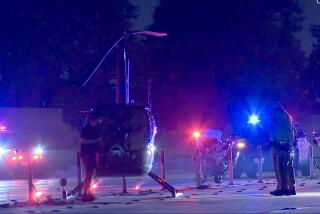‘Smart’ studs to light way for L.A. motorists
- Share via
A little bit of the future is coming to Los Angeles freeways later this year in the form of “smart” road studs that gauge road conditions and traffic flow and open and close a freeway lane accordingly.
Caltrans has contracted with a New Zealand company to pilot the “dynamic-lane” system on the 110 Freeway where traffic backs up in a tunnel at the single-lane connector to northbound Interstate 5. At peak hours, the “smart studs” would illuminate to automatically open a second connector lane on the 110, easing the long lines.
Despite a couple of delays -- the $3.2-million project had been set to roll out this month -- a Caltrans engineer said it’s on target to launch in November and, if successful, could be installed at other L.A. County junctions.
Tim Crabtree, chief executive of SmartStud, said the devices convert magnetic energy to electrical energy, known as inductive power transfer, which allows them to function independently from a fixed-cable system. Energy is delivered by a central cable that emits a magnetic field, but the studs do not need to be fixed by electrical wire to harness the electricity. A logical extension of the technology, Crabtree said, is a roadway-based system that can charge a vehicle’s battery as it moves along, or a system of road lights that responds dynamically to a vehicle’s speed.
The studs used in the Caltrans project will have embedded sensors that can transmit information over a frequency widely used in aircraft monitoring systems. The data on traffic flow and road and weather conditions are sent to a control center, which relays the information to electronic roadway signs, alerting drivers to resulting lane changes. The Caltrans project requires about 650 of the lights mounted close together in twin lines.
Crabtree said a recent project in Germany’s 5-mile Rennsteig Tunnel required 20 miles of the lights in four lines. He said it’s possible to install about two-thirds of a mile in one night shift.
He said the studs, which are sunk at a minimum of four inches, are easier to install and replace than traditional light studs.
Similar studs were installed in Santa Monica’s McClure Tunnel in 2003 to illuminate the freeway’s center divider, but they aren’t used for dynamic lane changes.
Sheik Moinuddin, a senior traffic engineer at Caltrans, said that the dynamic-lane project is the first of its kind in the city of Los Angeles, and that he’s optimistic it will reduce traffic jams and collisions. He said Caltrans was forced to innovate because the junction of the 110 Freeway and Interstate 5 is at a historic tunnel with a reservoir on one side and a cliff on the other, so the agency can’t make any major structural changes.
He said the system would operate between 3 and 7 p.m. at first and later, once drivers get used to it, work automatically during peak-flow hours.
“The embedded detectors on the roadway send feedback to a control center, which will operate automatically based on traffic demand to activate the second lane,” he said. “But at the beginning we will have to let the motorists get used to this system.”
So why not permanently open the second lane?
Because cars need to slow down before driving on the curved connector, Moinuddin said. A little bit of congestion, though annoying for drivers, can serve this purpose.
“At this point, we can’t have two lanes,” he said. “Only at peak hours can we have enough volume to carry through the lanes. At peak hours the traffic moves slowly. In other hours it’s low volume, so speed will be the major concern.
“We aim to balance traffic volume between through-move and connector-move: If volume is low for the connector, then heavy for the through-move, it’s a total imbalance. With a dynamic system, we can balance the flow.”
--
More to Read
Sign up for Essential California
The most important California stories and recommendations in your inbox every morning.
You may occasionally receive promotional content from the Los Angeles Times.













